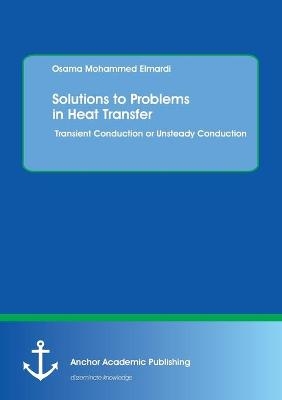
Solutions to Problems in Heat Transfer. Transient Conduction or Unsteady Conduction
Anchor Academic Publishing (Verlag)
978-3-96067-123-7 (ISBN)
The author's objective in this textbook is to develop procedures for determining the time dependence of the temperature distribution within a solid during a transient process, as well as for determining heat transfer between the solid and its surroundings. The nature of the procedure depends on assumptions that may be made for the process. If, for example, temperature gradients within the solid may be neglected, a comparatively simple approach, termed the lumped capacitance method or negligible internal resistance theory, may be used to determine the variation of temperature with time.
The entire book has been thoroughly revised and a large number of solved examples and additional unsolved problems have been added. This book contains comprehensive treatment of the subject matter in simple and direct language. The book comprises eight chapters. All chapters are saturated with much needed text supported and by simple and self-explanatory examples.
Text Sample:
Chapter One. Introduction:
From the study of thermodynamics, you have learned that energy can be transferred by interactions of a system with its surroundings. These interactions are called work and heat. However, thermodynamics deals with the end states of the process during which an interaction occurs and provides no information concerning the nature of the interaction or the time rate at which it occurs. The objective of this textbook is to extend thermodynamic analysis through the study of transient conduction heat transfer and through the development of relations to calculate different variables of lumped capacitance theory.
In our treatment of conduction in previous studies we have gradually considered more complicated conditions. We began with the simple case of one dimensional, steady state conduction with no internal generation, and we subsequently considered more realistic situations involving multidimensional and generation effects. However, we have not yet considered situations for which conditions change with time.
We now recognize that many heat transfer problems are time dependent. Such unsteady, or transient problems typically arise when the boundary conditions of a system are changed. For example, if the surface temperature of a system is altered, the temperature at each point in the system will also begin to change. The changes will continue to occur until a steady state temperature distribution is reached. Consider a hot metal billet that is removed from a furnace and exposed to a cool air stream. Energy is transferred by convection and radiation from its surface to the surroundings. Energy transfer by conduction also occurs from the interior of the metal to the surface, and the temperature at each point in the billet decreases until a steady state condition is reached. The final properties of the metal will depend significantly on the time - temperature history that results from heat transfer. Controlling the heat transfer is one key to fabricating new materials with enhanced properties.
Our objective in this textbook is to develop procedures for determining the time dependence of the temperature distribution within a solid during a transient process, as well as for determining heat transfer between the solid and its surroundings. The nature of the procedure depends on assumptions that may be made for the process. If, for example, temperature gradients within the solid may be neglected, a compara tively simple approach, termed the lumped capacitance method or negligible internal resistance theory, may be used to determine the variation of temperature with time.
Under conditions for which temperature gradients are not negligible, but heat transfer within the solid is one dimensional, exact solution to the heat equation may be used to compute the dependence of temperature on both location and time. Such solutions are for finite and infinite solids. Also, the response of a semi - infinite solid to periodic heating conditions at its surface is explored.
1.1 General Introduction:
Transient conduction is of importance in many engineering aspects for an example, when an engine is started sometime should elapse or pass before steady state is reached. What happens during this lap of time may be detrimental. Again, when quenching a piece of metal, the time history of the temperature should be known (i.e. the temperature - time history). One of the cases to be considered is when the internal or conductive resistance of the body is small and negligible compared to the external or convective resistance.
This system is also called lumped capacity or capacitance system or negligible internal resistance system because internal resistance is small, conductivity is high and the rate of heat flow by conduction is high and therefore, the variation in temperature through the body is negligible. The measure of the internal resistance is done by the Biot (Bi) number which is the ratio of the conductive to th
| Erscheinungsdatum | 20.03.2017 |
|---|---|
| Sprache | englisch |
| Maße | 155 x 220 mm |
| Gewicht | 183 g |
| Themenwelt | Technik ► Elektrotechnik / Energietechnik |
| Schlagworte | Energietechnik • heat transfer • Lumped capacitance system • mechanical engineering • Production Engineering • thermodynamics • Transient Conduction • Wärmetechnik |
| ISBN-10 | 3-96067-123-7 / 3960671237 |
| ISBN-13 | 978-3-96067-123-7 / 9783960671237 |
| Zustand | Neuware |
| Haben Sie eine Frage zum Produkt? |
aus dem Bereich


